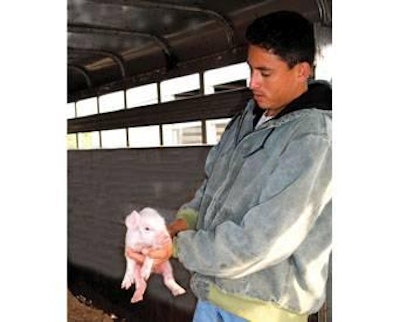
Two years and 33 states ago, the porcine epidemic diarrhea (PED) virus mysteriously entered the US — a country previously untouched by this deadly virus. More than 10 percent of the U.S. pig herd has been wiped out from the virus, which has three different strains circulating the country. The three genomic sequences of the PED virus share unique nucleotides with strains found in the Anhui Province, China. But, how the virus entered the U.S. is still unconfirmed.
The PED virus is a highly transmissible coronavirus that is deadly to neonatal piglets. The virus first entered the U.S. in April 2013, wiping out herds and putting producers in financial binds. Stringent biosecurity measures have been put into place, but farms are still breaking out with the virus. Contaminated feed, limited biosecurity and wind have been blamed as carriers of the disease.
Unlike its cousin, transmissible gastro-enteritis (TGE) virus, herds affected by the PED virus take weeks longer to recover. PED virus has also proven to be more resistant to biosecurity practices such as extreme heat and virucidal disinfectants. While the increase in on-farm biosecurity has slowed down the number of positive cases each month, there are still new outbreaks being reported in previously PED virus-negative states. It is inevitable that the virus will continue to spread through the U.S., but the speed at which it is spreading is slowing down steadily.
Biosecurity, immunity and structure: Three lessons in progress
1. Cleanliness is next to godliness. Not all virucidal disinfectants are created equal. According to research, heating a room or trailer to 160F (71.1C) for 10 minutes has proven successful when followed with a virucidal disinfectant. But not all virucidal disinfectants are effective at cleaning PED virus-contaminated trailers. Studies show that only some of the disinfectants actually work. Along with high heat and effective disinfectants, rooms and trailers need to be adequately dried to ensure they are free of the virus.
2. Herd immunity is fickle. Some farms have been able to build up herd immunity effectively. However, in other cases, farms have reportedly had sows that are able to raise a healthy litter of piglets in the same barn with sows that are losing their piglets to the virus. There are also farms that were thought to have built up a strong enough immunity to the virus experiencing a second breakout. It is unknown whether these herds are experiencing a new breakout of the PED virus or if the virus never actually left the farm. Herd immunity may also be the cause of the virus mutating into a new virus. This has yet to be confirmed.
3. Production models aren’t conducive to preventing the PED virus. Heightened biosecurity, such as changing apparel and boots between barns and washing trucks between loads, is not good enough when it comes to stopping the spread of the PED virus. The amount of activity from personnel and vehicles coming on and off the average farm makes it difficult to prevent the virus from entering the operation let alone contain it on the farm. And according to research it only takes a small particle the size of a pencil eraser to infect an entire farm.
Documentation and biosecurity is key to containing the virus
Documenting the PED virus, the re-breakouts and mutated strains are crucial to diagnosing clinical signs and combating the disease. Out of the three strains currently in the U.S., two entered the U.S. in 2013. The third strain is a mutated strain that may have been caused by herds building immunity to the initial PED virus strain. To help understand the different clinical signs and possible cures, the United States Department of Agriculture (USDA) has mandated that all farms report their herds when infected and work with a veterinarian to develop a useful protocol. Multiple organizations, universities and companies are working day-in and day-out to learn how the disease develops and its characteristics.
Aside from on-farm management and disease documentation, simply containing the disease from spreading is a breakthrough. It’s believed that the main source of transporting the disease is via the trucks and trailers moving pigs from farm to farm and to the packing plant. Trailers need to be pressure-washed at 160F (71.1C), cleaned with a virucidal disinfectant that has been proven to prevent the PED virus and then completely dried in order to keep from transporting the disease to another farm. Research also shows that the virus is airborne and can spread downwind from infected farms.
PEDv advances U.S. disease prevention protocol
Previous to the onset of PED virus biosecurity and disease communication in the swine industry were adequate compared to 20 or 30 years ago. But, it is since the disease has hit the U.S. that precautions and research have come to the forefront. In just two years producers, researchers and companies have come together to educate and find a way to eradicate the virus. Everyone in the swine industry is familiar with the PED virus. And biosecurity, disease research and information sharing have increased drastically in the past two years.
Two years of research and biosecurity measures are not enough. As the industry is learning more, it is also learning how vulnerable and unprepared it is for other disease breakouts. The PED virus epidemic has been a wake-up call to the necessary changes that need to be made to the production model, biosecurity and prevention. But, it takes time, money and knowledge to make these changes, something that the industry is short on physically, financially and emotionally.
The boon in international business proves a bane to disease prevention
Given the amount of global business traffic in the 20th century, it is no surprise that highly transmissible viruses can travel over thousands of miles of ocean to wipe out thousand-strong pig herds. And the PED virus is not least among viruses that are naive to the U.S. pig herd. It is vital to advance the current protocol and biosecurity used in the U.S. and globally. The devastating effect that one virus has had on the U.S. swine herd has left the industry almost expectant of another virus to come in and completely wipe them out.
U.S. Outlook: The swine industry can only get better
There is no doubt in the minds of producers, veterinarians and researchers that the U.S. swine industry will recover. But, the industry will also never be the same. The painful experience of the PED virus has created a cautious industry that is expectant of another virus to come in and finish what PED virus started. It is this level of concern that has brought on action individually, nationally and globally. And with more new cases of the virus being reported — though at a slower level than a year ago — it is well accepted that the PED virus is here to stay, and that it is containable and preventable.















